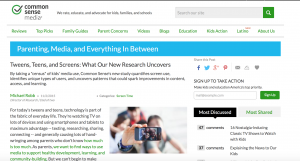When to put the device down

Let’s face it, it’s a challenge to balance technology in our lives; but it’s essential.
Parents and adults need to guide their young adolescents and children towards developing this balance. Arguably, we don’t have good technology habits ourselves, but the modeling and mentoring of developing a healthy relationship with technology is a critical role for parents.
Balancing screen time with family time
I don’t do much (or any) Thanksgiving television watching, but I read in the New York Times this week about a thought-provoking Verizon commercial airing on Thanksgiving. The commercial features typical families, young and old people commuting and “devicing” (yes, I made up that verb) their way towards a Thanksgiving gathering.
The point? Sometimes you need a smart phone, tablet, or even wearable technology; but at times like this event, you need to put it away.

Resources for parents
Here are some resources to share with parents and families of your students around striking a balance between screen time and family time.
Common Sense Media has excellent ( and free) material for parents seeking to guide their children. These include family guides of movies, television, apps and more.
The Parent Concerns and Parent blog “helps families understand and navigate the problems and possibilities of raising children in the digital age”.
Common Sense Media may be providing the most robust collection of resources — there’s certainly enough material there — but I like this resource, as well: Janell Burley Hofmann writes a blog about finding a balance between tech and life – particularly aimed at parents. Her book iRules has helpful content for parents, as well.
Finally, I find this chapter in The Distraction Addiction by Alex Soojung-Kim Pang to be helpful:
Eight Steps to Contemplative Computing
- Be Human – First, appreciate that entanglement with technology is a part of life. Second, recognize that computers can affect how we see ourselves.
- Be Calm – it’s active rather than passive, being disciplined and self-aware
- Observe what helps you be mindful online and what doesn’t
- Make Conscious Choices – choose technology tools when it’s of greater value than the alternative
- Use devices in ways to extend your abilities – using them as tools for training and enriching our minds
- Seek Flow – find opportunities of when your abilities and the challenge are perfectly balanced
- Use technology in ways that engage you with the world
- Use technology in ways that are restorative – renew your capacity for attention
Let’s notice that adhering to these eight steps would result in some sort of Buddhist enlightenment. Perhaps the language is a bit lofty for use with adolescents. But the ideas and aspirations are worthwhile discussions and foundations for healthy habits. What’s important is that we recognize the need for parents to help their children develop this balance.



Balancing screen time and family time: resources for parents https://t.co/3vfe3NNizd https://t.co/nvb6gRqJ3D
RT @innovativeEd: Balancing screen time and family time: resources for parents https://t.co/3vfe3NNizd https://t.co/nvb6gRqJ3D
RT @innovativeEd: Balancing screen time and family time: resources for parents https://t.co/3vfe3NNizd https://t.co/nvb6gRqJ3D
Balancing screen time and family time https://t.co/taTcRlPKp2 via @innovativeEd
For the a.m. crowd: Balancing #screentime & family time: resources for families #vted https://t.co/tsVFtMwn9P